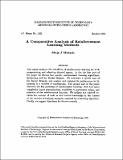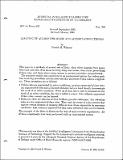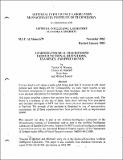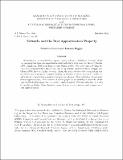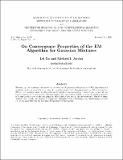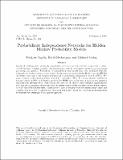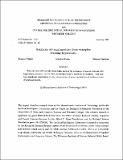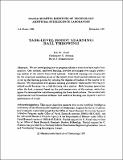Browsing AI Memos (1959 - 2004) by Subject "learning"
Now showing items 1-14 of 14
-
A Comparative Analysis of Reinforcement Learning Methods
(1991-10-01)This paper analyzes the suitability of reinforcement learning (RL) for both programming and adapting situated agents. We discuss two RL algorithms: Q-learning and the Bucket Brigade. We introduce a special case of the ... -
Generating and Generalizing Models of Visual Objects
(1985-07-01)We report on initial experiments with an implemented learning system whose inputs are images of two-dimensional shapes. The system first builds semantic network descriptions of shapes based on Brady's smoothed local ... -
Learning a Color Algorithm from Examples
(1987-06-01)We show that a color algorithm capable of separating illumination from reflectance in a Mondrian world can be learned from a set of examples. The learned algorithm is equivalent to filtering the image data---in which ... -
Learning by Augmenting Rules and Accumulating Censors
(1982-05-01)This paper is a synthesis of several sets of ideas: ideas about learning from precedents and exercises, ideas about learning using near misses, ideas about generalizing if-then rules, and ideas about using censors to ... -
Learning object segmentation from video data
(2003-09-08)This memo describes the initial results of a project to create a self-supervised algorithm for learning object segmentation from video data. Developmental psychology and computational experience have demonstrated that the ... -
Learning Physical Descriptions from Functional Definitions, Examples, and Precedents
(1982-11-01)It is too hard to tell vision systems what things look like. It is easier to talk about purpose and what things are for. Consequently, we want vision systems to use functional descriptions to identify things when ... -
Networks and the Best Approximation Property
(1989-10-01)Networks can be considered as approximation schemes. Multilayer networks of the backpropagation type can approximate arbitrarily well continuous functions (Cybenko, 1989; Funahashi, 1989; Stinchcombe and White, 1989). We ... -
Neural Networks
(1996-03-13)We present an overview of current research on artificial neural networks, emphasizing a statistical perspective. We view neural networks as parameterized graphs that make probabilistic assumptions about data, and view ... -
On Convergence Properties of the EM Algorithm for Gaussian Mixtures
(1995-04-21)"Expectation-Maximization'' (EM) algorithm and gradient-based approaches for maximum likelihood learning of finite Gaussian mixtures. We show that the EM step in parameter space is obtained from the gradient via a ... -
Probabilistic Independence Networks for Hidden Markov Probability Models
(1996-03-13)Graphical techniques for modeling the dependencies of randomvariables have been explored in a variety of different areas includingstatistics, statistical physics, artificial intelligence, speech recognition, image ... -
Recognition and Structure from One 2D Model View: Observations on Prototypes, Object Classes and Symmetries
(1992-02-01)In this note we discuss how recognition can be achieved from a single 2D model view exploiting prior knowledge of an object's structure (e.g. symmetry). We prove that for any bilaterally symmetric 3D object one non- ... -
Synthesis of Visual Modules from Examples: Learning Hyperacuity
(1991-01-01)Networks that solve specific visual tasks, such as the evaluation of spatial relations with hyperacuity precision, can be eastily synthesized from a small set of examples. This may have significant implications for the ... -
Task and Object Learning in Visual Recognition
(1991-01-01)Human performance in object recognition changes with practice, even in the absence of feedback to the subject. The nature of the change can reveal important properties of the process of recognition. We report an ... -
Task-Level Robot Learning: Ball Throwing
(1987-12-01)We are investigating how to program robots so that they learn tasks from practice. One method, task-level learning, provides advantages over simply perfecting models of the robot's lower level systems. Task-level ...

